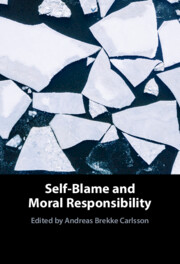Book contents
- Self-Blame and Moral Responsibility
- Self-Blame and Moral Responsibility
- Copyright page
- Contents
- Contributors
- Acknowledgments
- Introduction
- Part I The Nature of Self-Blame
- Chapter 1 The Motivational Theory of Guilt (and Its Implications for Responsibility)
- Chapter 2 The Trials and Tribulations of Tom Brady
- Chapter 3 A Comprehensive Account of Blame
- Chapter 4 A Forward-Looking Account of Self-Blame
- Part II The Ethics of Self-Blame
- Part III Self-Blame and Moral Responsibility
- References
- Index
Chapter 2 - The Trials and Tribulations of Tom Brady
Self-Blame, Self-Talk, Self-Flagellation
from Part I - The Nature of Self-Blame
Published online by Cambridge University Press: 05 May 2022
- Self-Blame and Moral Responsibility
- Self-Blame and Moral Responsibility
- Copyright page
- Contents
- Contributors
- Acknowledgments
- Introduction
- Part I The Nature of Self-Blame
- Chapter 1 The Motivational Theory of Guilt (and Its Implications for Responsibility)
- Chapter 2 The Trials and Tribulations of Tom Brady
- Chapter 3 A Comprehensive Account of Blame
- Chapter 4 A Forward-Looking Account of Self-Blame
- Part II The Ethics of Self-Blame
- Part III Self-Blame and Moral Responsibility
- References
- Index
Summary
When Tom Brady throws an interception, he yells at himself and pounds his fists on his helmet. When Serena Williams misses a shot, she breaks her racket. When Tiger Woods misses a long putt, he falls to his knees and shakes his head. These athletes are clearly blaming themselves. Surprisingly, though, current theories of blame have a very hard time accounting for such cases. Most theories of blame take other-blame – directly expressed dyadic blame – as their paradigm, typically thought to be a response to poor quality of will or moral wrongdoing and consisting of some kind of relationship modification, communication, or protest. None of these features seems to apply in the cases of athletic self-blame. Recently, some theorists have taken self-blame to be a more fundamental paradigm than other-blame, but they are focused on self-blame as guilt, which again can’t capture the athletic cases, because Tom, Serena, and Tiger aren’t feeling anything like guilt when they blame themselves. As a result of these problems, I offer a new theory of self-blame, one that starts by theorizing directly about the athletic cases. I draw from some fascinating recent psychological work on the phenomenon of self-talk to make the case that the emotional core of self-blame is in fact very different than that of other-blame, as is evidenced in a new puzzle I introduce about hypocrisy and its limits.
- Type
- Chapter
- Information
- Self-Blame and Moral Responsibility , pp. 28 - 47Publisher: Cambridge University PressPrint publication year: 2022
- 8
- Cited by

